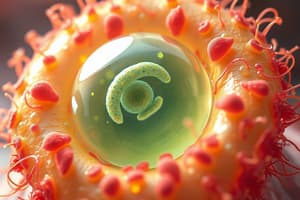Podcast
Questions and Answers
What is a microscope?
What is a microscope?
A laboratory instrument used to examine objects that are too small to be seen by the naked eye.
Which part of the microscope supports the entire structure?
Which part of the microscope supports the entire structure?
- Stage
- Revolving Nosepiece
- Base (correct)
- Eyepiece
What is the function of the coarse adjustment knob?
What is the function of the coarse adjustment knob?
Used for rough focusing of the specimen.
What phase follows interphase in the cell cycle?
What phase follows interphase in the cell cycle?
What is mitosis?
What is mitosis?
Match the following phases of mitosis with their description:
Match the following phases of mitosis with their description:
Cells always grow before they divide.
Cells always grow before they divide.
The process of cell division that produces two identical daughter cells is called ______.
The process of cell division that produces two identical daughter cells is called ______.
Flashcards are hidden until you start studying
Study Notes
Microscope: Parts and Functions
- Microscopes are essential tools in biology for examining small objects undetectable by the naked eye.
- Key parts of a compound microscope include:
- Stand/Base: Provides stability; typically horse-shoe shaped.
- Inclination Joint: Allows tilting of the upper microscope section.
- Substage: Located beneath the stage; contains the iris diaphragm and condenser.
- Stage: Holds the microscope slide; features an opening for light passage.
- Arm/Handle: Connects the base to the body tube.
- Stage Clips: Secure the slide in place.
- Fine Adjustment Knob: Smaller knob for precise focusing on details.
- Coarse Adjustment Knob: Larger knob for initial rough focus.
- Revolving Nosepiece: Holds and allows rotation of objective lenses.
- Body Tube (Head): Supports the eyepiece and objectives.
- Draw Tube: Hosts the eyepiece.
- Mirror: Directs light from the source towards the specimen.
- Iris Diaphragm: Controls light intensity passing through the condenser.
- Eyepiece: The lens used for viewing samples.
- Objectives: Lenses of varying magnification (LPO: 10X, HPO: 40X/43X/45X, Oil Immersion: 97X/100X).
- Microscopes require careful handling to prevent damage and accidents.
Cell Cycle
- The cell cycle in eukaryotic cells consists of two main phases: interphase and mitotic (M) phase.
- During interphase, the cell grows and duplicates its DNA; during the mitotic phase, it divides into two cells.
Interphase
- Comprised of three key phases:
- G1 Phase: Cell grows, organelles replicate, and essential building blocks are produced.
- S Phase: DNA synthesis occurs, producing a complete DNA copy and duplicating centrosomes.
- G2 Phase: Continued growth, protein and organelle synthesis, and preparation for mitosis take place.
- Interphase includes the G1, S, and G2 phases, occurring between successive mitotic phases.
Mitosis
- Mitosis is the process of cell division producing two genetically identical daughter cells from one mother cell.
- Key stages of mitosis:
- Prophase: Chromosomes condense, becoming visible as sister chromatids.
- Metaphase: Chromosomes align at the cell's equatorial plane.
- Anaphase: Sister chromatids separate and move towards opposite poles.
- Telophase: Nuclear membranes reform around each set of separated chromosomes.
- Mitosis leads to equal distribution of DNA before cytokinesis, which ultimately divides the cytoplasm and completes cell division.
Studying That Suits You
Use AI to generate personalized quizzes and flashcards to suit your learning preferences.



